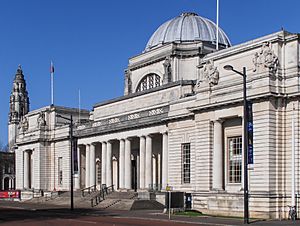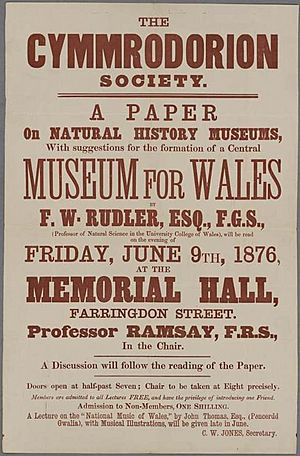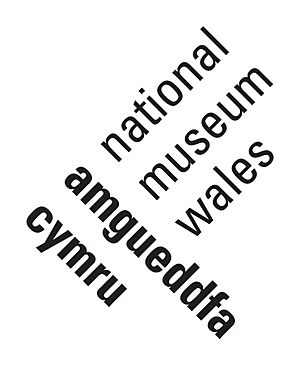Amgueddfa Cymru – Museum Wales facts for kids

Logo used since August 2022
|
|

National Museum Cardiff, its main site
|
|
| Established | 1907 |
|---|---|
| Location | Cardiff; Blaenavon; Llanberis; Swansea; Caerleon; Dre-fach Felindre; St Davids |
| Type | Welsh Government sponsored body |
| Visitors | 1.89+ million (2017) |
Amgueddfa Cymru – Museum Wales is a group of seven amazing museums across Wales. Think of it as a big family of museums! It was officially started in 1907 and is one of the biggest museum groups in the whole United Kingdom. It's super important for sharing the culture and history of Wales.
Amgueddfa Cymru runs seven main museums. These include the National Museum Cardiff (its biggest one!), St Fagans National Museum of History, Big Pit National Coal Museum, National Wool Museum, National Slate Museum, National Roman Legion Museum, and the National Waterfront Museum. It also has a special art gallery called Oriel y Parc in St Davids and a huge storage place for its collections in Nantgarw.
These museums hold incredible collections from all over the world, especially focusing on Wales. You can see everything from ancient animals and plants (natural history) to old tools (archaeology), beautiful paintings (art), and stories about how people worked in factories and mines (industrial heritage). Lots of people visit these museums every year – over 1.89 million! St Fagans National Museum of History, which opened in 1948, was the first national outdoor museum in the UK and is still one of the best in Europe.
Amgueddfa Cymru's main goal is to 'Inspire people, changing lives'. This means they want to protect and explain the amazing history and nature of Wales. When it first started, the idea was to show off Wales's rocks, animals, plants, ancient cultures, old tools, art, history, and important jobs. Today, the museums still teach and research, but in modern ways. The Welsh Government helps pay for the museums, and the best part is, it's free to visit all of them!
Contents
History
How it Started (1905–1907)
The National Museum of Wales officially began in 1905. King Edward VII gave it a special document called a Royal Charter on March 19, 1907. This document said the museum's main job was to show everything about Wales: its rocks, animals, plants, ancient cultures, old tools, art, history, and important jobs. Starting this museum was part of a bigger plan to create important Welsh cultural places, like the National Library of Wales, which also got its special document on the same day.

To help Cardiff become the home of the new National Museum, the city offered its own museum collection. This collection, once called the 'Welsh Museum of Natural History, Archaeology and Art,' was officially given to the new National Museum in 1912. Before that, the Cardiff Museum shared a building with the Cardiff Library.
Building the First Museum (1908–1927)
Work on the main museum building in Cathays Park started in 1912. Architects Arnold Dunbar Smith and Cecil Brewer designed it. King George V himself laid the first stone on June 26, 1912. But because of the First World War, building took a lot longer. The museum finally opened its doors to visitors on October 28, 1922, and had its big official opening party in 1927.
Important leaders, called directors, helped guide the museum in its early years. These included William Evans Hoyle (from 1908 to 1924) and the famous archaeologist Sir Mortimer Wheeler (from 1925 to 1926). Then came Sir Cyril Fox (from 1926 to 1948), who helped the museum grow a lot.
Growing the Museum Family (1940s–1960s)
In the middle of the 1900s, the museum started to grow beyond just its main building in Cardiff. A huge step was creating St Fagans National Museum of History. This museum started in 1946 when the Earl of Plymouth gave St Fagans Castle and its land. It opened to everyone on July 1, 1948, as the Welsh Folk Museum. It was the very first national outdoor museum in the UK!
The idea for St Fagans came from a Welsh poet and museum expert named Iorwerth Peate. He was inspired by a similar outdoor museum in Sweden called Skansen. Many of the items you see at St Fagans today first came from a special 'Welsh Bygones' gallery that opened in the National Museum in Cardiff back in 1926.
Modern Times and Industrial Stories (1970s–1990s)
By the early 1970s, the museum had new spaces for showing exhibits, offices, and workshops. Three new galleries opened: one for everyday objects (Material Culture) in 1970, one about farming (Agricultural) in 1974, and a gallery for clothes (Costume) in 1976.
In the 1980s, many old factories and mines in Wales were closing, just like farms had changed years before. So, the museum decided to tell these stories too. In 1987, real ironworkers' homes from Merthyr Tydfil were moved to St Fagans. This showed that the museum was now also focusing on Wales's industrial past, not just its rural history.
The museum family kept growing with new museums dedicated to Wales's industrial history. These included the National Slate Museum in Llanberis, the Big Pit National Coal Museum in Blaenavon, and the National Wool Museum in Dre-fach Felindre.
Today's Museums (2000–Present)
The 2000s brought big improvements to the museums. St Fagans National Museum of History had a huge makeover that finished in 2018. It cost £30 million! Because of these amazing changes, it was named the Art Fund Museum of the Year in 2019. The revamp added three new galleries about Welsh history, made buildings better, and improved things for visitors.
In 2015, Amgueddfa Cymru decided on a new goal: 'Inspiring people, changing lives'. This guides everything they do. They also got a new look, with their current logo introduced in August 2022.
Leaders like Michael Houlihan (2003–2010), David Anderson (2010–2023), and the current Director General Jane Richardson (since 2023) have helped the museum keep growing. They make sure the museums continue to protect and share Wales's culture and nature in ways that are interesting for everyone today.
Just recently, in October 2025, the museum launched its new online image library called Amgueddfa Cymru Images. This means you can now explore over 2,000 pictures for free! It includes photos and images of objects showing Wales's social life, industries, and nature. You can even see famous artworks by artists like Van Gogh, Monet, and Renoir from their collection.
Explore the Museums
Amgueddfa Cymru has seven main museums across Wales, plus a special art gallery and a big place to store all their treasures. Each museum focuses on a different part of Wales's culture and nature. You can learn about art, animals, plants, old factories, and ancient history!
| Museum Name | What You'll Find | Where It Is | Opened | Image |
|---|---|---|---|---|
| National Museum Cardiff | Animals, plants, art, and ancient history | Cardiff Cathays Park |
1922 |  |
| St Fagans National Museum of History | Welsh life, old buildings, and culture | Cardiff St Fagans |
1948 |  |
| Big Pit National Coal Museum | Coal mining and factory history | Blaenavon, Torfaen | 1983 |  |
| National Waterfront Museum | Sea history, industries, and new ideas | Swansea | 2005 |  |
| National Slate Museum | Slate mining and Welsh industrial history | Llanberis, Gwynedd | 1972 |  |
| National Roman Legion Museum | Roman history and ancient finds | Caerleon, Newport | 1850 |  |
| National Wool Museum | Welsh wool and fabric making | Dre-fach Felindre, Carmarthenshire | 1976 |  |
| Oriel y Parc | Welsh landscape art and Pembrokeshire heritage | St David's, Pembrokeshire | 2005 | |
| National Collections Centre | Collections storage and conservation | Nantgarw, Rhondda Cynon Taf | 1993 |
The industrial heritage museums, Big Pit National Coal Museum, National Slate Museum, and National Wool Museum, show how people worked in Wales's past. You can even go on an underground mine tour at Big Pit! The National Roman Legion Museum has important Roman army items found at the Isca Augusta fortress.
Amazing Collections
Amgueddfa Cymru's collections are truly special and include items from all over the world.
- Natural History: There are over 6 million items, like plants, animals, rocks, and fossils. They show a lot about Wales's own nature and geology.
- Archaeology: This collection has ancient items from prehistoric times all the way to the Middle Ages. You can see cool Roman finds from Caerleon and very old tools from across Wales.
- Art: You'll find Welsh art from the 1500s to today, famous European paintings, and one of the best collections of Impressionist art in the world. These were mostly given by the Davies sisters in the 1950s and 1960s.
- Industrial Heritage: These items tell the story of Wales's big role in the Industrial Revolution. You can see tools, machines, and learn about the lives of people who worked in coal mining, slate quarrying, and making textiles.
Museum Leaders
Here are the people who have led the National Museum of Wales as Directors:
| No. | Portrait | Director | Term start | Term end |
|---|---|---|---|---|
| 1 | William Evans Hoyle | 1908 | 1924 | |
| 2 | Sir Mortimer Wheeler | 1925 | 1926 | |
| 3 |  |
Sir Cyril Fox | 1927 | 1948 |
| 4 | D. Dilwyn John | 1948 | 1968 | |
| 5 | Gwyn Jones | 1968 | 1977 | |
| 6 |  |
Douglas Bassett | 1977 | 1985 |
| 7 | David W. Dykes | 1986 | 1989 | |
| 8 | Alastair Wilson | 1989 | 1993 | |
| 9 | Colin Ford | 1993 | 1998 | |
| 10 | Anna Southall | 1998 | 2002 | |
| 11 | Michael Houlihan | 2003 | 2010 | |
| 12 | David Anderson | 2010 | 2023 | |
| 13 | Jane Richardson | 2023 | Incumbent |


